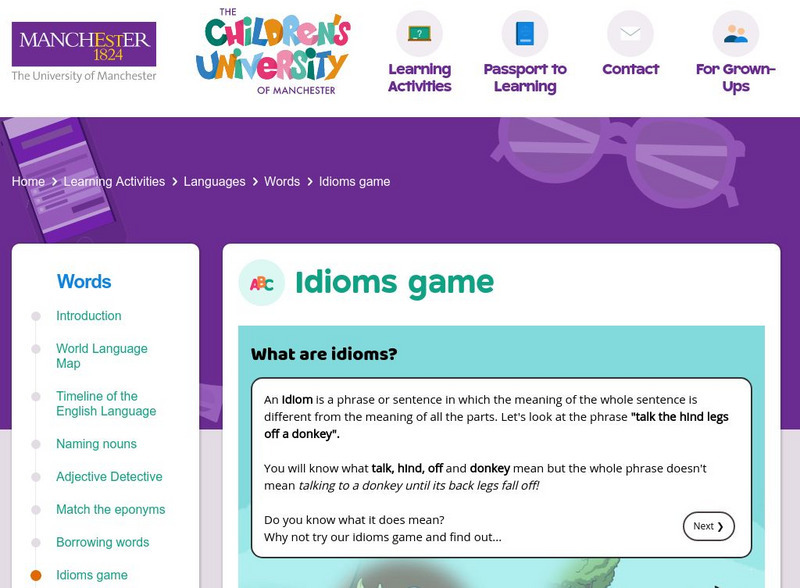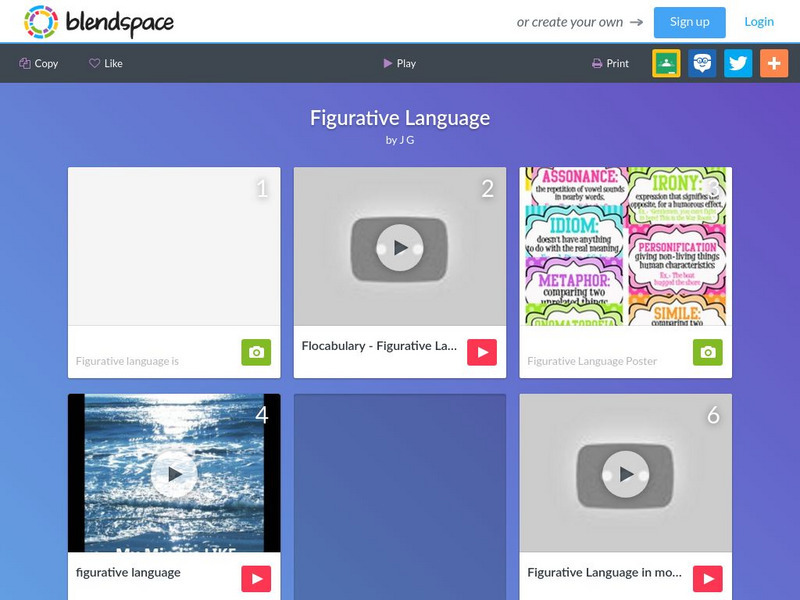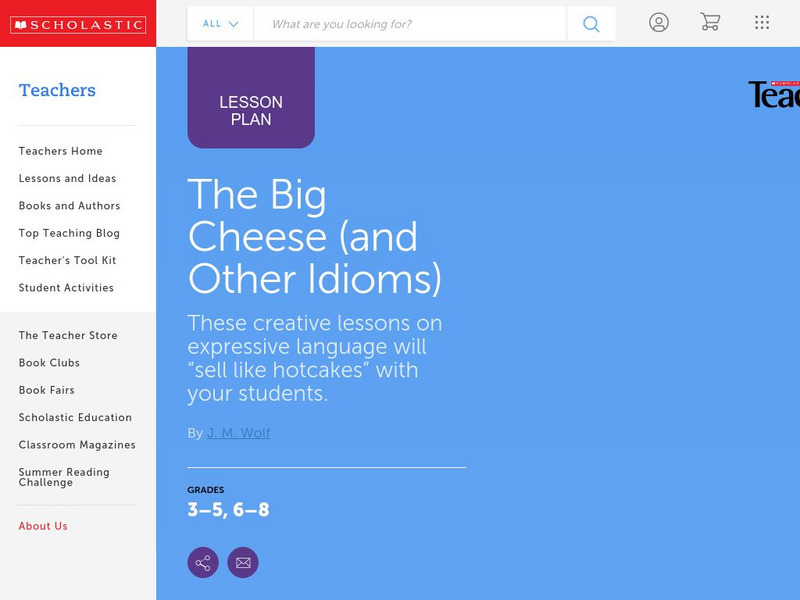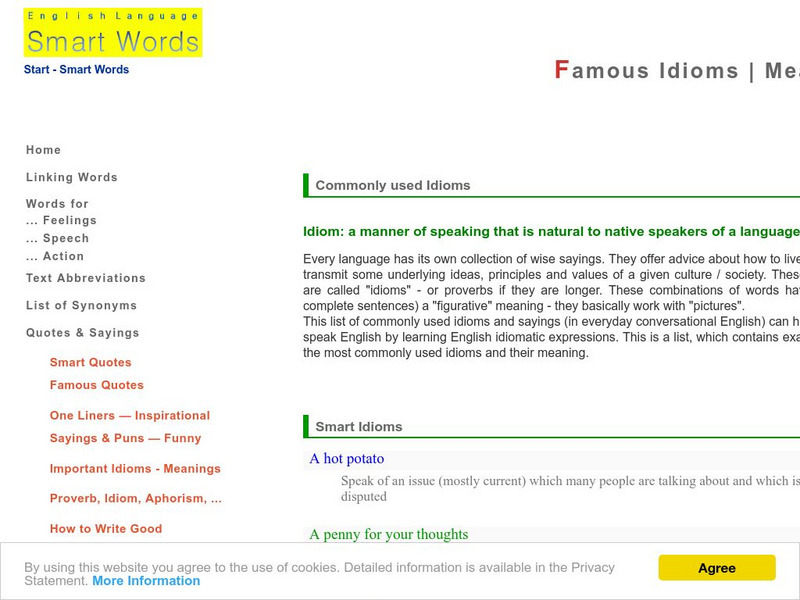University of Victoria (Canada)
The U Vic Writer's Guide: Literary Term: Fable
The University of Victoria's English department gives a comprehensive definition of fables. Example included.
University of Manchester
Children's University of Manchester: Words: Idioms Game
Colorful quiz asks students to choose the correct meanings of popular idioms.
Vocabulary University
My vocabulary.com: Classic Books Vocabulary
This is an index of links of novels and vocabulary word lists from them. Click on a specific book/novel/play to see the printalble list of vocabulary words. These include classics such as 1984, Tale of Two Cities, Angela's Ashes, Da...
TES Global
Blendspace: Cause and Effect
This eleven-part Blendspace is designed to be used while teaching students how to analyze cause and effect. Links include reference sheets, a SMART Notebook Lesson, posters, practice worksheets, and guided practice opportunities.
E Reading Worksheets
E Reading Worksheets: Idiom Worksheets
This site provides seven worksheets to help students understand idioms and their figurative meanings better. In each exercise, students will explain the meaning of idioms that are embedded into sentences.
Road to Grammar
Road to Grammar: English Idioms
This interactive site focuses on English idioms; it defines idioms, offers an extensive glossary of idioms, and provides practice understanding idioms.
TES Global
Blendspace: Figurative Language
A twelve-part learning module on figurative language including links to images, videos, a song, and a game to help students learn.
Grammarly
Grammarly Blog: What Are Homophones?
This page explains homophones (words that sound alike, but have different spellings and meanings) and provides the most common examples.
Grammarly
Grammarly Blog: Sometime, Sometimes, and Some Time
An explanation with examples of using the words "sometime," "sometimes," and "some time" correctly in sentences.
Scholastic
Scholastic: The Big Cheese and Other Idioms
Find out more about idioms through this informative resource. This site provides activities and ideas revolving around sharpening your knowledge of idioms.
Merriam-Webster
Merriam Webster: Anecdote/definition
A good extensive definition of "anecdote" and the origin of the word.
E Reading Worksheets
E Reading Worksheets: Figurative Language: Reading Test 3
A ten-question quiz on recognizing similes, metaphors, hyperbole, and personification. Results can be printed, saved, or emailed.
Read Works
Read Works: 3rd Grade Lesson: Poetry
[Free Registration/Login Required] A lesson plan in which students use two provided poems to learn to identify and understand the use of similes and metaphors in poetry. Lesson includes direct teaching, guided practice, and independent...
Read Works
Read Works: Fourth Grade: Three Lesson Unit: Figurative Language
[Free Registration/Login Required] A lesson plan, based on In a Pickle and Other Funny Idioms by Marvin Terba, in which young scholars learn how understand idioms and use them to explain the plot and to make predictions. With free login,...
Other
Pitara: Kids Proverbs
Browse samples from this collection of kids proverbs from India or search by keyword.
University of Victoria (Canada)
Elc Study Zone: Basic Subordinating Conjunctions
This English language tutorial explains subordinating conjunctions. Offers charts, examples, and links to self-tests.
Other
Smart Words: Famous Idioms and Meaning
This is a list of the 50 most commonly used idioms and their meanings.
McGraw Hill
Mc Graw Hill: Vocabulary Acquisition and Use: Understand Figurative Language
Explains what similes and metaphors are and how they are alike and different. Provides examples and practice sheets for each.
CommonLit
Common Lit: "The Crow and the Pitcher" by Aesop
This story is part of his collection of tales known as "Aesop's Fables," which were passed down by people retelling them. They have deeply influenced children's literature and modern storytelling culture. As you read, take notes on the...
Alabama Learning Exchange
Alex: Figurative Language
This instructional activity used a slideshow presentation to explain the difference between similes and metaphors. Students are challenged to identify these figurative elements in literature and then create some themselves.
Khan Academy
Khan Academy: Common Expressions: Medium
Can you spot the correct prepositions to use in these conventional expressions?
ABCya
Ab Cya: Hold the Phone an Idiom Game
Hold the Phone is a great way to learn idioms! Kids will be able to illustrate idioms with emojis, learn the meanings of idiomatic expressions, and then use them in a sentence. Hold the phone...this is super fun!
Louisiana Department of Education
Louisiana Doe: Louisiana Believes: Ela Guidebooks: Word Displays
This strategy helps students understand vocabulary as the read and refine their language skills in support of writing about texts.
Louisiana Department of Education
Louisiana Doe: Louisiana Believes: Ela Guidebooks: Semantic Mapping
A strategy for developing students' vocabulary by representing the concepts of words graphically. This helps refine their understanding of vocabulary to meet expectations in reading and language.

















